Reconstructing the ocean's interior from surface data
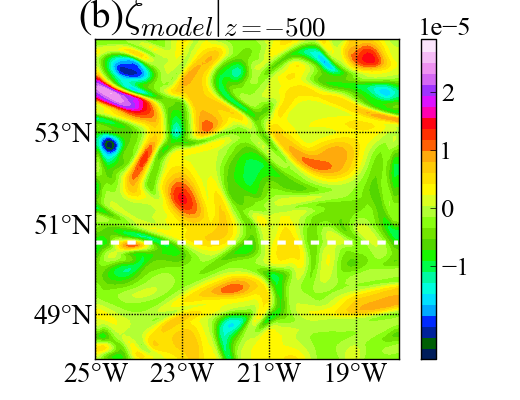
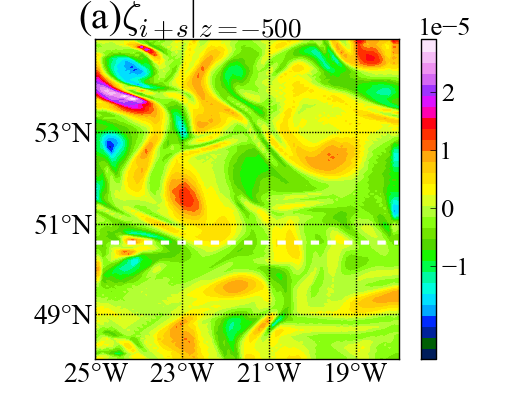 While our knowledge of the ocean surface has been tremendously expanded in this modern satellite era, measurements of the ocean interior remain sparse and expensive to obtain.
A suitable framework that can derive sub-surface information from sea surface data becomes very important in expanding the coverage of ocean measurements.
We propose a method to reconstruct the flows in the ocean interior using both sea surface temperature and sea surface height data. The method works well based on a test using a high resolution
numerical simulation. The relative vorticity at 500 meter depth in the reconstructed field (right) matches the original model result (left).
While our knowledge of the ocean surface has been tremendously expanded in this modern satellite era, measurements of the ocean interior remain sparse and expensive to obtain.
A suitable framework that can derive sub-surface information from sea surface data becomes very important in expanding the coverage of ocean measurements.
We propose a method to reconstruct the flows in the ocean interior using both sea surface temperature and sea surface height data. The method works well based on a test using a high resolution
numerical simulation. The relative vorticity at 500 meter depth in the reconstructed field (right) matches the original model result (left).
The python program is available from popy (github.com/jinbo/popy). You can find a tutorial here.
Radiating Instabilities

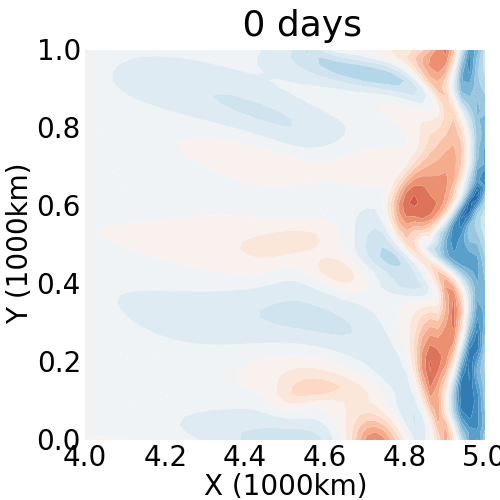
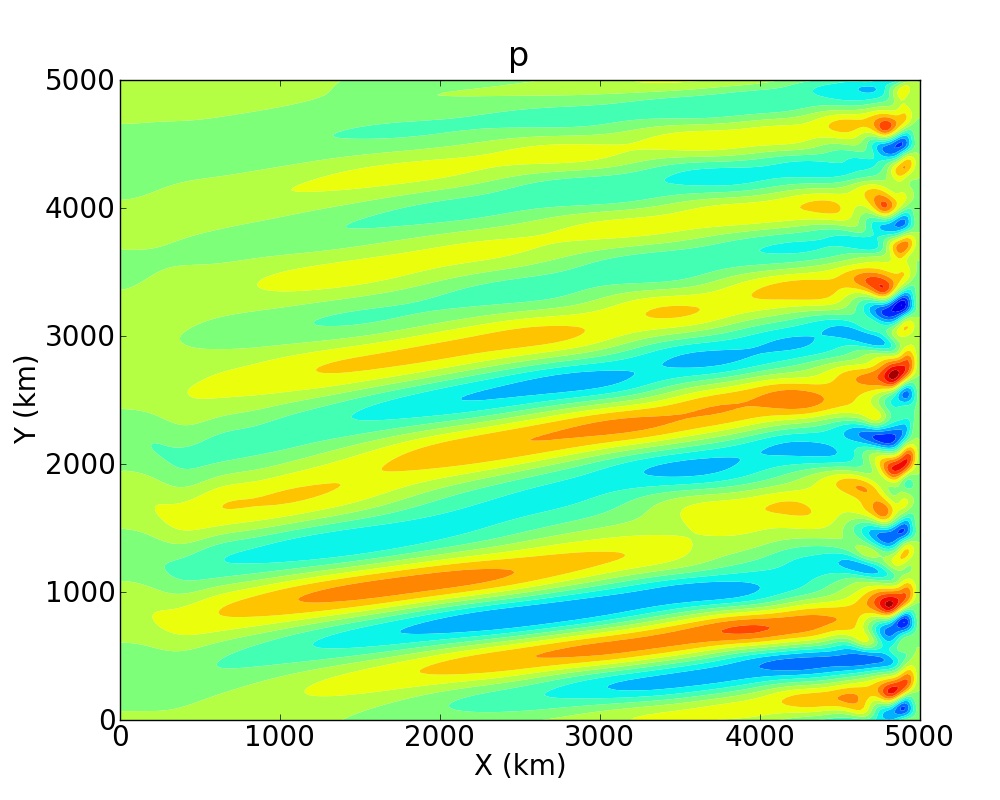 Eastern oceanic boundary currents are subject to hydrodynamic instability, generate small scale features that are visible in satellite images and may radiate westward into the interior.
The stability of an eastern boundary current is studied in an idealized framework represented by barotropic quasi-geostrophic dynamics.
The linear stability analysis of a meridional current with a continuous velocity profile shows that meridional eastern and western boundary currents support a limited number of radiating modes
with long meridional and zonal wavelengths and small growth rates. However, the linearly stable, long radiating modes of an eastern boundary current can become nonlinearly unstable by
resonating with short trapped unstable modes. This phenomenon is clearly demonstrated in the weakly nonlinear simulations. Results suggest that linearly stable longwave modes deserve more
attention when the radiating instability of a meridional boundary current is considered. The radiating instability can form zonal striations in the open ocean.
Eastern oceanic boundary currents are subject to hydrodynamic instability, generate small scale features that are visible in satellite images and may radiate westward into the interior.
The stability of an eastern boundary current is studied in an idealized framework represented by barotropic quasi-geostrophic dynamics.
The linear stability analysis of a meridional current with a continuous velocity profile shows that meridional eastern and western boundary currents support a limited number of radiating modes
with long meridional and zonal wavelengths and small growth rates. However, the linearly stable, long radiating modes of an eastern boundary current can become nonlinearly unstable by
resonating with short trapped unstable modes. This phenomenon is clearly demonstrated in the weakly nonlinear simulations. Results suggest that linearly stable longwave modes deserve more
attention when the radiating instability of a meridional boundary current is considered. The radiating instability can form zonal striations in the open ocean.
The influence of a large-scale flow on the radiating instability of an eastern boundary current
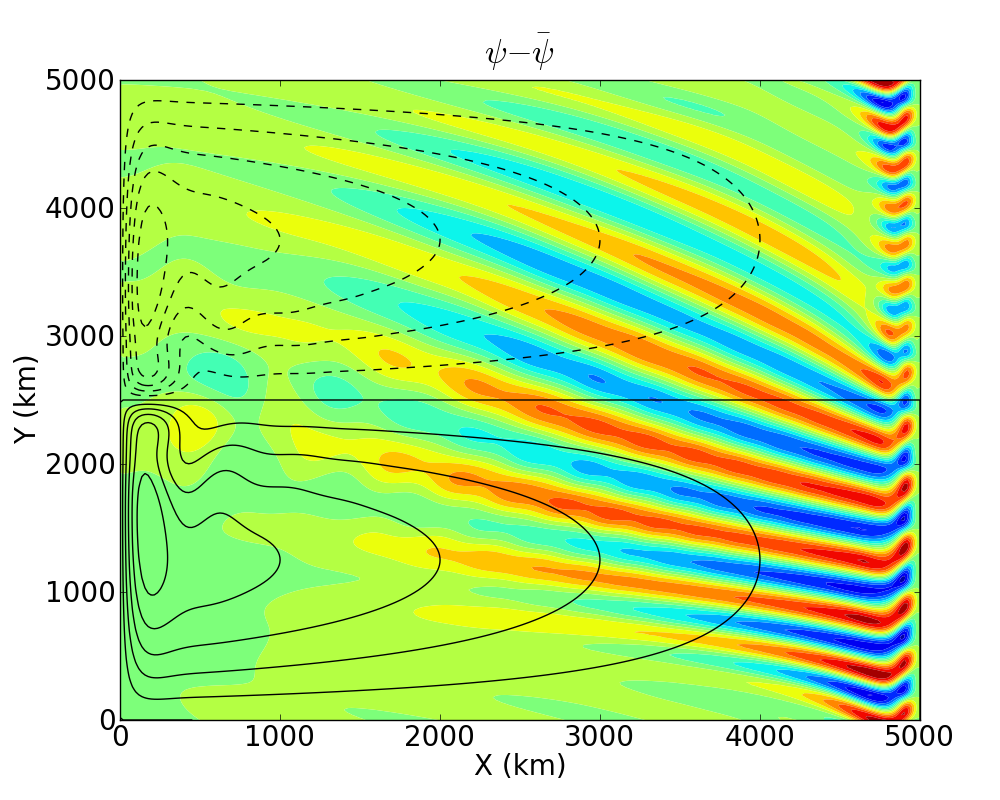 A large-scale flow can affect the radiating instabilities of an eastern boundary current. It affects the short trapped unstable mode and long radiating mode through different mechanisms.
The large-scale flow modifies the structure of the boundary current to stabilize or destabilize the unstable modes,
leading to a meridionally localized maximum in the perturbation kinetic energy field. The shortwave mode is accelerated
or decelerated by the meridional velocity adjustment of the large-scale flow to have an elongated or a squeezed meridional
structure, which is confirmed both in a linear WKB analysis and in nonlinear simulations. The squeezed or elongated unstable
mode detunes the nonlinear resonance with the longwave modes, which then become less energetic. These two modes show
different meridional structures in kinetic energy field because of the different mechanisms.
A large-scale flow can affect the radiating instabilities of an eastern boundary current. It affects the short trapped unstable mode and long radiating mode through different mechanisms.
The large-scale flow modifies the structure of the boundary current to stabilize or destabilize the unstable modes,
leading to a meridionally localized maximum in the perturbation kinetic energy field. The shortwave mode is accelerated
or decelerated by the meridional velocity adjustment of the large-scale flow to have an elongated or a squeezed meridional
structure, which is confirmed both in a linear WKB analysis and in nonlinear simulations. The squeezed or elongated unstable
mode detunes the nonlinear resonance with the longwave modes, which then become less energetic. These two modes show
different meridional structures in kinetic energy field because of the different mechanisms.
On the warm bias over the upwelling regions along subtropical eastern boundaries in climate models
Coastal upwelling along eastern boundaries of subtropical ocean basins
plays an important role in both regional and global climate. Cold sea
surface temperatures (SST) induced by the coastal upwelling favor
the formation of stratocumulus clouds, which influence the earth's
radiation budget by reflecting shortwave radiation. Cold SSTs along
the eastern boundaries of subtropical ocean basins act to enhance the tropical inter-hemispheric SST gradient,
which influences the meridional migration of the Inter-tropical Convergence Zone (ITCZ) over both the Pacific and Atlantic.
Meridional migrations of the ITCZ have broad impacts on the rainfall over tropical oceans and adjacent continents.
However, current couple climate models can not correctly simulate the regional climate over the upwelling regions, and produce a common warm bias that can exceed $3^oC$ and extend about three hundred kilometers offshore and several thousand kilometers along the coast.
The warm biases are caused by air-sea coupled processes. I investigated the problem from an oceanic perspective, which has been overlooked in previous studies. By comparing a set of numerical simulations using the MITgcm, I found that the entrainment cooling by coastal upwelling is nonlinearly related to the amplitude of upwelling velocity, which is further related to the model horizontal resolution. A simple parameterization scheme is proposed to increase the upwelling cooling by reducing vertical diffusivity in the model grid adjacent to the boundary.
Wang J., (2008): On the warm bias along the South-West African Coast in coupled models: an oceanic perspective. M.S. thesis, MIT/WHOI Joint Program in Oceanography.
However, current couple climate models can not correctly simulate the regional climate over the upwelling regions, and produce a common warm bias that can exceed $3^oC$ and extend about three hundred kilometers offshore and several thousand kilometers along the coast.
The warm biases are caused by air-sea coupled processes. I investigated the problem from an oceanic perspective, which has been overlooked in previous studies. By comparing a set of numerical simulations using the MITgcm, I found that the entrainment cooling by coastal upwelling is nonlinearly related to the amplitude of upwelling velocity, which is further related to the model horizontal resolution. A simple parameterization scheme is proposed to increase the upwelling cooling by reducing vertical diffusivity in the model grid adjacent to the boundary.